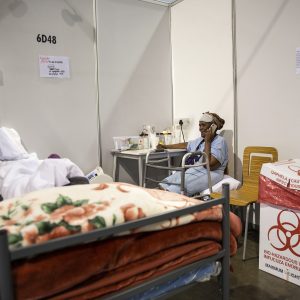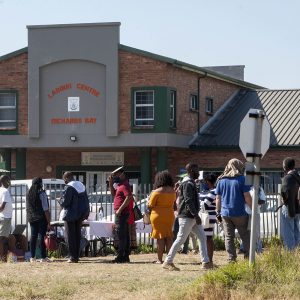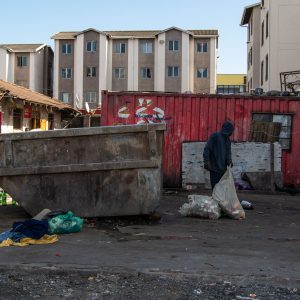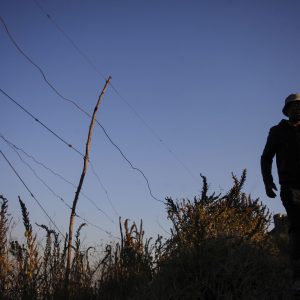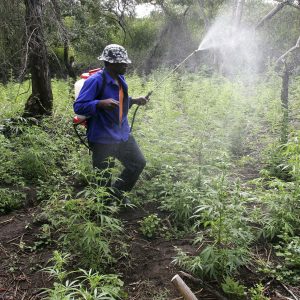Long Read | SA must fix its ‘dop system’
The Covid-19 lockdown has exposed the effects of South Africa’s weak alcohol regulations. Government and health campaigners want tougher policies, but the liquor giants are pushing back.
Author:
21 September 2020

Over 20 years ago, when Charles Parry began urging government officials to get tougher on the alcohol industry, he heard some smug jibes from liquor executives. “You’re not going to get anywhere,” they told him. “We have better access. We braai with these guys [government officials].” In 2010, he learned that the industry were plying top government officials with World Cup hospitality tickets.
But braais and box seats were merely the froth on the surface of a deep compact between the African National Congress (ANC) government and South Africa’s booze tycoons – a compact that replicated similar alliances with the apartheid state. Suddenly, that cosy deal looks shaky: the Covid-19 pandemic has pooped the party.
Parry is the director of the South African Medical Research Council’s (SAMRC) Alcohol, Tobacco and Other Drug Research Unit. And he says that one of the consolations of the trauma of lockdown is, or must be, a national “moment of clarity”. The destructive weakness of South Africa’s regulation of the alcohol trade is finally and painfully visible to the ANC, he believes, and that is a major step forward.
But it is far from irreversible, Parry warns. The booze barons are fighting back. And the loosening of alcohol regulations announced as part of the level one lockdown last week – with retail sales permitted on Fridays, suggests their lobbying efforts might just be paying off.
Related article:
The second ban on the sale of alcohol, imposed in early July, was a shock for the industry. “They were completely caught off guard,” says Parry, whose research on the calamitous effect of heavy drinking on non-natural death rates and hospital trauma admissions helped motivate the decision. “Because they weren’t consulted before the second ban.”
President Cyril Ramaphosa – a former board member of South African Breweries (SAB) – had told liquor executives quite bluntly that alcohol was not a necessity for South Africans, “non-essential”. They had reason to expect a bit more love from a government that had long looked kindly on their dizzying profits. After all, former finance minister and Ramaphosa ally Trevor Manuel currently sits on the board of SAB, while former SAB executive Vincent Maphai had a seat on the first national planning commission. The state and the industry were old drinking buddies, in short.
Parry is an alcohol epidemiologist, a psychologist by training and an increasingly outspoken campaigner. He is one of many leading public health scientists around the world who once enjoyed quiet lives, but have been compelled by the attack of the pandemic to step into the public square. He considers it part of his job to communicate the brutal realities contained in his research.
He is no prohibitionist – he drinks socially himself. Instead he believes that South Africa’s relentless tide of alcohol-related violence and disease can be drastically stemmed through sensible, evidence-based policy.
Parry’s arguments were not part of the rationale for the first booze ban in mid-March. That move was championed by police minister Bheki Cele as a measure to control crime and possible popular resistance during the hard lockdown, and also to give hospitals a chance to prepare for the expected onslaught of Covid-19 cases.
Then, as if by magic, the price of easy access to alcohol became shockingly clear – by its sudden absence. Within days of the hard lockdown, emergency wards were all but empty – and all-cause death numbers plummeted below the curve of expected deaths for March and April. This effect should not have come as a surprise, especially to health workers. But it was still dramatic – and it vindicated Parry’s long-standing advice to government.
Related article:
So his models were vital when the time came to fight the booze barons in court. “I only got brought in when there were legal cases against the government. At the beginning, the rationale for the alcohol ban was around policing and crime. And then it became the trauma beds, even though at that point there wasn’t a shortage. It really should have been around physical distancing.”
Immediately after the first booze ban was lifted, hospital emergency wards were swamped with stabbing, gunshot, assault and road traffic victims. The second ban suppressed the wave of trauma yet again, while its lifting summoned it back. That phase of the prohibition “experiment” represented a vital control, because the lifting of the second ban had not coincided with the potentially confounding factor of restricted movement, as had occurred with the lifting of the first ban.
“Data from Tygerberg Hospital in Bellville, Cape Town, shows trauma ward admissions rising 120% in the weekend after the second lockdown ended – from 75 cases to 155 cases. Eighty-five percent of those cases were clinically assessed to be alcohol-related.” Comparable spikes in violent injuries were seen at Groote Schuur and Chris Hani Baragwanath hospitals.
‘If you hit us, you hit them’
Parry and many other activists believe that the ruling party has belatedly woken up to its power to protect citizens from harm. But the executive fiat required was only possible due to state-of-disaster powers provided for in the Constitution, which will not and must not last. “We’ve seen a change, but it’s not a guarantee,” says Parry. “Because they’re talking to the industry, and the industry is notorious for undermining evidence-based policy. They want government to agree to a social compact on alcohol. The first version of it looked promising, but in later versions, you could see the industry weakening the plan by emphasising the role of education, and limiting its focus to drink driving, and drinking during pregnancy. Those are real problems, but they are not the whole problem. Interventions in those areas don’t dramatically hit the industry’s bottom line.”
During the bans, the liquor industry began to fire off diversionary claims. “They said the European Union was upset about the ban – but in fact it was the European Spirits Council (an industry body concerned about a dip in exports) who were upset.”
Related article:
The liquor giants placed adverts emphasising the plight of small black business owners – drivers, distributors, taverners, small barley growers. “It was a case of look, government, if you hit us, you’re going to hit these guys too. But the fact remains that large parts of the industry are monopolised by very large companies, which aren’t even really South African-owned companies. A lot of the profits are taken offshore to foreign shareholders. And the industry could easily have supported those people who were out of work during the ban.”
But the most disturbing problem, Parry says, is that the liquor giants’ business model depends on widespread heavy drinking. Over 50% of drinkers are heavy drinkers – amounting to 17% of the adult population.
“So the model would not function if everyone drank responsibly. They wouldn’t make the profits that shareholders want.”
Drunk or sober
Another very big problem, of course, is that alcohol is lovely. Addiction counsellors may not agree with this claim. They will argue that alcohol creates more anxiety and depression than it does pleasure. That it creates the emotional void that it appears, deceptively, to fill. But that neat formula simply doesn’t capture the double-edged power of alcohol.
The bottle is, for many of us, a portal to violence, discord, pain, depletion and chaos. But it can also offer another portal: to social connection, creativity, erotic disinhibition, wit, honesty, tranquillity, consolation, courage.
Those two opposing sets of effects can coincide in one person, one night, one lifetime. Hugh Masekela, a famously reformed drinker and drug user, knew all about this paradox. When I interviewed him in 2015, months before his death, Masekela told me about his work in helping alcoholic artists to sober up – and his stubborn misgivings about the culture of addiction treatment.
“I’ve been quite successful [in helping alcoholics],” he said. “But I’ve lost a few people who I’ve intervened with. The percentages are very low. And when you’re in an addictive country, it’s difficult to be healthy – to feel like I feel now is almost miraculous.”
Related article:
In his teens in Johannesburg, he was a moderate drinker. “I remember meeting girls and they’d say: ‘You don’t drink? Shit! A man who doesn’t drink? I could never hang out with you. Oooh, a kang bhora! [You would bore me to death!] Nee man, vat ’n suipie!’ [No, man, grab a drink!]”
As he got older, Masekela became unsettled by what he saw as the totalising glumness of organised sobriety. “Now and again I will have a glass of wine or a shot. When I was in rehab in England and South Africa, and going to meetings, everybody was scared and uncomfortable. I wasn’t getting any inspiration.
“One day I stood up and said, you know, you’re all really bringing me down. You’re all miserable as shit. You don’t seem to be enjoying your recovery. I’m enjoying mine. I can’t be part of this.”
But the messiness of the meaning of alcohol – the wide, blurry spectrum between cost and reward, pleasure and destruction – should not mean a messy policy on its sale and use. Functional drinkers have no right to cheap and convenient booze if it kills and sickens countless others.
Alcohol policy activist and researcher Maurice Smithers recently spoke to a doctor at Cape Town’s Groote Schuur Hospital, who told him that what he noticed after the end of the first lockdown was “the return of the unmistakable smell of alcohol mixed with blood”.
Drinking while black: the backstory
Smithers is director of the Southern African Alcohol Policy Alliance in South Africa, which fights for better alcohol regulation. He is also writing a book on the long and vexed history of that regulation in South Africa. Our policy framework is built on the legacy of British colonial alcohol policy, Smithers says – and as a result is actually tougher than the almost non-existent regulatory regimes in other postcolonial countries. He cites Brazil, which followed the Portuguese approach: you can buy booze at almost any shop, liquor licences aren’t required and levels of abuse are unsurprisingly appalling. One town in São Paulo state, however, achieved a sharp drop in its murder rate simply by reducing operating hours for bars.
In early colonial South Africa, as in Latin America, liquor was a powerful currency of trade – and domination. “Brewed liquor was widespread in precolonial societies, but not the hard tack offered as barter by the colonists,” says Smithers. “So there was a material impact on populations unaccustomed to distilled liquor. In South Africa, booze was used as a means of payment and control through the dop system, and the impact of that still resonates today. We have the highest rate of foetal alcohol syndrome in the world, centred mainly in the Western Cape and Northern Cape, where the dop system was predominant.”
Related article:
In the early years of the Transvaal gold boom, mine bosses also used alcohol to control workers: they noticed that those black migrant labourers who drank took longer to save the hut taxes demanded by the colonial authorities, which meant they stayed on the mine for longer, providing a steadier labour force. In time, the bosses noticed that liquor was hurting productivity. They couldn’t ban booze for white miners, so they called for a ban restricted to black miners instead – but President Paul Kruger wasn’t having it. Many of his farming constituents were selling grain and potatoes to the distilleries, who supplied the hundreds of new drinking establishments across the reef. Those included “shebeens” – the Irish term for an illegal bar, which followed Irish workers in the 1880s to the Johannesburg brothel district of Frenchfontein, around Rissik and President streets. However, bans on blacks drinking “white” liquor slowly became the norm in the dying years of the 19th century.
After the turn of the century, vigorous attempts were made to prevent black women in cities from brewing and selling beer – and black workers were encouraged to drink in municipality-owned beer halls rather than shebeens. This strategy was part of what became known as the “Durban system”. The profits from these beer halls were used to subsidise the infrastructure of urban oppression – hostels, barracks, administration and policing. “It was a bizarre situation,” says Smithers. “It was in the interest of city councils to sell as much sorghum beer as they could.”
But Durban’s black women brewers, whose work had been made illegal in 1908, weren’t buying this deal. They organised boycotts of the beer halls in 1926 and again in 1959. (The recurring opposition to beer halls was not only about unfair competition; it was also about the psychological and physical fate of the husbands and fathers lining the benches. As late as 1976, beer halls were targeted during the Soweto uprising.)
A ban on the sale of alcohol to black people finally came with the 1928 Liquor Act. “There were various amendments,” says Smithers, “including one that said black people who manifested civilised behaviour were allowed a permit to buy alcohol. Like a qualified-franchise approach: you were ‘civilised enough to handle your alcohol like a white man’. Which was, of course, complete rubbish. White workers can and do drink just as heavily and dangerously.” ”
Enter the shebeen queen
Predictably, the ban of 1928 created a massive shadow booze economy – revolving around the shebeens, hidden in the back rooms of township homes, which became the major source of ‘white’ liquor for black drinkers. From 1928 until 1961, when the ban was lifted to boost tax receipts, the shebeen queens (and plenty of kings) provided the nocturnal stage of township culture. From Sophiatown and Atteridgeville to Cato Manor and Gugulethu, shebeens dished up a beguiling package of bootleg whisky, hot jazz and urbane cool. Shebeens must have seen countless romantic comedies of the kind described by Masekela, in which fresh plaasjapies tried their luck with fast kasie women. They also saw a lot of bloodshed.
Even after 1961, when black drinkers could buy “white” booze legally from white suppliers, the shebeens carried on regardless. On the demand side, they still gave drinkers a relaxed bar on the corner; on the supply side, they still offered the rare chance of an independent income for blacks. As the transition to democracy approached, many shebeens formalised and became licenced taverns, but many also became unofficial wholesalers, supplying illegal shebeens in their areas. In the postapartheid era, SAB (later ABInbev) became powerful partners for taverners. The company provided stock, credit and distribution support. In return, the taverners provided massive custom – and significant political cover as broad-based empowerment partners.
Related article:
“Shebeens have been mythologised and fetishised,” says Smithers. “They are linked to the romance of the Sophiatown era and all its cultural icons: Masekela, Miriam Makeba, the Drum writers, Mandela. But Sophiatown was a very violent, dangerous place. We can’t entirely discard the romance. But by leaving them alone to operate as usual, we ignore the extraordinary damage done to the fabric of communities. There is this idea that taverns and shebeens are an integral part of township culture that must be preserved, and that any intensifying legislative control will hit townships hard.
“That may well be true,” says Smithers. “But the issue is why we still have that situation – 30 years after the repeal of the Group Areas Act, which forced black people out of the broader economy and forced them into taverns, taxis and tuckshops as the only economically independent industries?
“Why are the departments of trade and industry and small business development not helping taverners to move into more sustainable and productive businesses? Few people are getting rich. As a member of a liquor traders association once said to me: ‘Nobody wants to die selling alcohol – most subsistence outlets sell alcohol to make enough money to be able not to sell alcohol’.”
The taverner’s dilemma
Lucky Ntimane agrees – up to a point. As convenor of the National Liquor Traders Council, Ntimane has become a key powerbroker in the negotiations over policy change. “Owning a tavern is a hand-to-mouth existence,” he says. “Owners don’t aspire to be anything but breadwinners. It’s about making R50 to buy candles and paraffin for the next day.”
He says the manufacturers promote an existing strategy to encourage “responsible drinking”, led by the industry-funded body Aware.org. “But we taverners have no say on those interventions. The onus is on us to implement what they recommend. We can’t have a situation where they are the only ones who develop a strategy. The board of Aware should include liquor traders. It’s misguided that at the moment, it doesn’t.”
Ntimane says taverners are exploring ways to diversify to offset any drop in income due to tougher regulations. “We are engaging with Bidfood, to tap into that opportunity of retailing and serving food, and also meeting with Walmart [the owners of Massmart and Makro].
“These are good ideas on paper, but they need funding from the industry. We also want responsible drinking. But the liquor industry has been in existence for a long time. We shouldn’t be talking about strategies, we should be implementing them.”
Related article:
He disputes Parry’s view that a decline in “problem drinking” would inevitably cut the industry’s profits. “Responsible drinkers can drink in different places and times – they can drink at home, or at a tavern, or at a restaurant. They can plan their purchases, so they are a profitable customer base.”
The Food and Allied Workers Union (Fawu), which represents workers across the alcohol sector, is not convinced by this argument. Fawu spokesperson Vuka Chonco says: “We are not disputing that alcohol is a contributing factor to accidents and inappropriate behaviour. But if policy changes do have an adverse influence on jobs, we will have to engage with government to find ways to mitigate that. It must not defeat the responsibility of government to create and protect jobs.”
Chonco cites the recent imposition of the sugar tax as a cautionary example. “There were many retrenchments. Because where there are cost implications for an industry, they pass that cost onto consumers, who then buy less, and business then retrenches workers.”
Guns and boozers
If South African does tighten alcohol laws, the potential benefit in controlling violence would likely also require improved gun control. Adèle Kirsten, director of Gun Free South Africa, says that the easy availability of both guns and alcohol is a combination that drives high rates of violence all over the world. There are nuances within that broad correlation.
Kirsten mentions a femicide study carried out by Naeema Abrahams at the SAMRC, which compared femicide data from the years 1999 and 2009. “What is interesting is that they tracked blood-alcohol content levels of both victims and perpetrators, and women who were shot and killed by their intimate male partner typically had a lower blood-alcohol level than women killed in other ways, such as with a blunt instrument, stabbing or strangulation. Their conclusion was that with all other instruments of violence, often both the victim and perpetrator are drunk. But with gun femicide, the victim was more often sober. Because even if you’re sober, you can’t run away from a gun.”
She says the pandemic has raised hopes for better gun control – with a caveat. “Some people were saying, when this reduction in gun violence happened, this is Gun Free SA’s mission come alive. And I said, ‘Hang on – let’s think about the increasing police repression we saw. This is not what a gun-free South Africa looks like.’”
The price of peace
For the SAMRC’s Charles Parry, we don’t need heavier policing – we need heavier pricing. “The minimum unit cost of beer, for instance, could be raised significantly from its current level of between R4 and R6 a standard unit of 12g of absolute alcohol.” Making booze more expensive at the lower end, he argues, would be the most effective way to curb heavy drinking, along with reducing trading hours for bottle stores and taverns. “If people have less time to drink, they drink less,” says Parry.
“The industry would benefit from raising the floor price of alcohol. It would only lose if the government increased excise taxes – which they should as excise taxes on alcohol are less now than they were in the 1970s.”
Some of the hit on profits imposed by an excise increase and restricted operating hours could be offset by the industry saving R1 billion to R2 billion if marketing is banned or severely restricted – another measure that has been proven to cut consumption.
Parry is also calling for smaller bottle sizes – beer is widely sold in 750ml quarts and even one litre bottles, allowing drinkers to tell themselves they are ordering “a drink” when in fact they are ordering three or four drinks.
To witness the power of minimum unit pricing, one should simply try to get drunk in the Nordic countries – you will have to blow a lot of money to do so. State monopolies control all alcohol retail, with punitive sin taxes applying to hard tack in particular.
Despite the high level of trust and compliance in the Nordic states, this model inevitably triggers a bit of naughtiness. Says Pia Mäkelä, a professor at the Finnish Institute for Health and Welfare and the University of Helsinki: “Illicit trade is not a big thing in Finland, but legal travellers’ imports from Estonia in particular is a big thing, as there is only a two-hour boatride between our capital, Helsinki, and theirs, Tallinn. About one-fifth of all alcohol consumed in Finland comes from travellers’ imports – this is a soft way of ‘rebelling against’ the high alcohol taxation in Finland.”
Related article:
But Finnish alcohol policy is much lighter than it was 87 years ago, when a prohibition was lifted. “Since 1932, alcohol consumption and related harms have mostly increased. So ‘success’ is relative, but our history supports the view that more lax alcohol policies are associated with increased alcohol consumption.”
One anomaly is that young Finns are drinking less than they used to, as are young people in many countries. But Mäkelä attributes this to a cultural shift, related to the rise of social-media engagement, rather than policy effects. She says the Finnish state’s heavy taxation of alcohol generates a surplus beyond the direct public health costs of treating alcohol abuse. “But if we try to include hidden costs, then the situation changes. These costs include hospitalisations for injuries, which seldom get an attribution to alcohol in the records even when they should, and the costs to society and employers for the ensuing sick leave, unemployment or disability pensions.” (South African sin taxes on alcohol don’t even cover the direct social costs of alcohol, much less the broader costs Mäkelä mentions.)
One of the riddles of alcohol policy worldwide is the “alcohol harm paradox”: rich people tend to drink just as much as poor people, and often more, but suffer fewer harms from illness or violence. “A part of this can be attributed to drinking patterns,” says Mäkelä. “Those who are worse off can have a slightly greater proportion of heavy drinkers and binge drinking, but this is only a partial explanation. The worse-off people seem to be more vulnerable to the effects of drinking, perhaps due to [the rich having] better health care or better nutrition or better safety nets and buffers against adversities.”
This paradox is visible both between rich and impoverished countries, and between the rich and impoverished within countries, she says.
And the cruelty of that dynamic is most starkly clear in South Africa – in our emergency wards, in our homes, in our streets.
Too many of us are literally dying for a drink. Something has to give.

